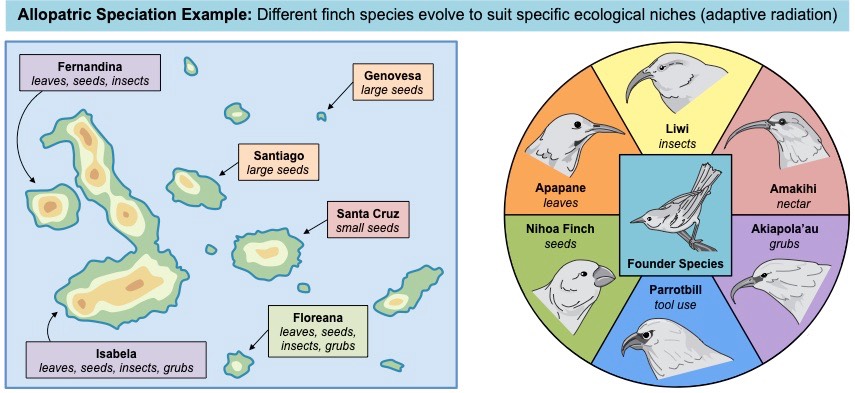Key Knowledge:
|
Speciation is an evolutionary process that results in the formation of a new species from a pre-existing species
- A species is a population whose members have the potential to interbreed to produce fertile, viable offspring
Speciation occurs when reproductive barriers prevent two populations from interbreeding – there is no gene flow between gene pools
- Consequently, the two populations begin to evolve separately as a result of cumulative mutation, genetic drift and natural selection
- Eventually the two populations reach a degree of genetic divergence whereby they can no longer interbreed (speciation)
Types of Speciation
There are two main types of speciation that can occur according to the mechanism of reproductive isolation:
- Allopatric speciation involves the geographic separation of a population, while sympatric speciation does not involve physical separation

Allopatric Speciation
Allopatric speciation occurs when a geographical barrier physically isolates the populations of an ancestral species
- The populations will therefore be exposed to different environmental selection pressures and evolve along divergent pathways
An example of allopatric speciation can be seen in the variety of beak types seen in the finches of the Galapagos Islands
- These finches have specialised beak shapes depending on their primary source of nutrition (e.g. seeds, insects, nuts, nectar)
- The finches occupied a variety of distinct ecological niches (different islands) with no gene flow between populations
- Over time, this leads to the rapid evolutionary diversification of a single ancestral line (adaptive radiation)

Sympatric Speciation
Sympatric speciation occurs when a population becomes reproductively isolated without being physically separated
- In other words, it involves the divergence of species within a shared geographical location (i.e. no physical separation)
- The reproductive isolation can be caused by temporal or behavioural factors, or caused by chromosomal abnormalities (polyploidy)
An example of sympatric speciation can be seen in the different species of Howea palms on Lord Howe Island
- Howea palms are endemic to Lord Howe island (single location), but may be exposed to different soil conditions (volcanic vs calcareous)
- Palms growing in nutrient-rich volcanic soil (more acidic) tend to flower earlier than palms growing in calcareous soil (more basic)
- Because the palms were flowering at different times, reproduction ceased to be random (assortative mating began to occur)
- This temporal isolation between the two populations of palms caused them to evolve along different pathways (i.e. disruptive selection)
- Over time, the gradual accumulation of genetic differences caused the populations of Howea palms to form separate species
